The summer solstice has arrived, and a “heat dome” over Colorado arrived with it. It’s amazing me at all the terms meteorologists have come up with over the years to describe weather phenomenon that we just used to call summer.
Anyway, before the heat rolled there was lots of activity here in the Vintage Garden. Certainly not as frenzied as last year’s front yard renovation, but activity nonetheless. Let me show you some of the things we have been up to since the garden came out of its winter slumber.
Cutting down a mutant tree
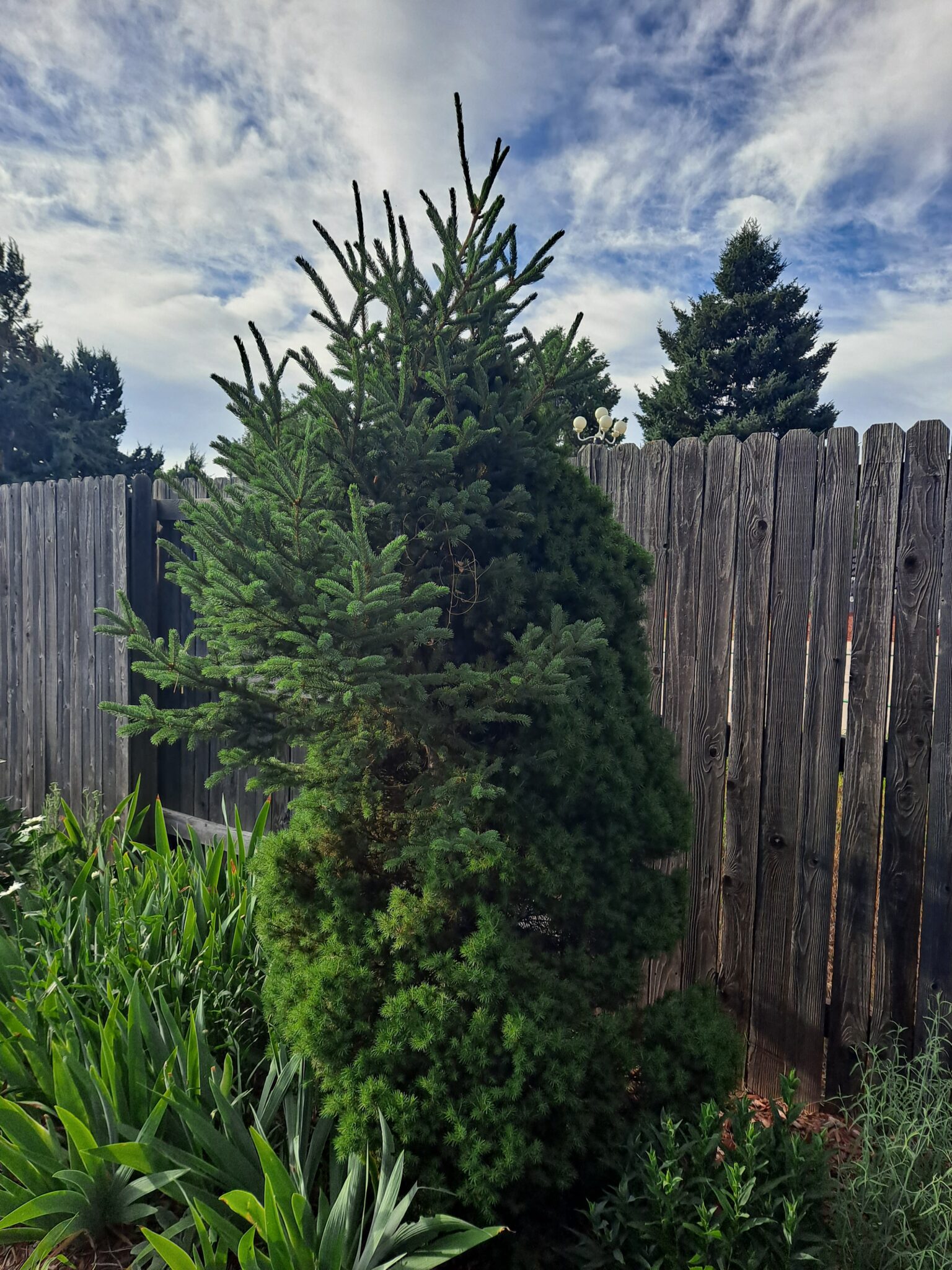
Many years ago we planted a dwarf Alberta spruce in the long border in the backyard. This occurred during my dwarf conifer infatuation. It is normal for gardeners to go through several obsessions during their lifetime. For a brief period, I wanted to create a mini-Rocky Mountain forest in our yard. The fad passed, but the plants remained.
For years this dwarf Alberta spruce just did its thing, slowly growing and just being innocuous. Then, about 6 or 7 years ago, something strange happened to it. A growth appeared that looked completely different from the rest of the tree:
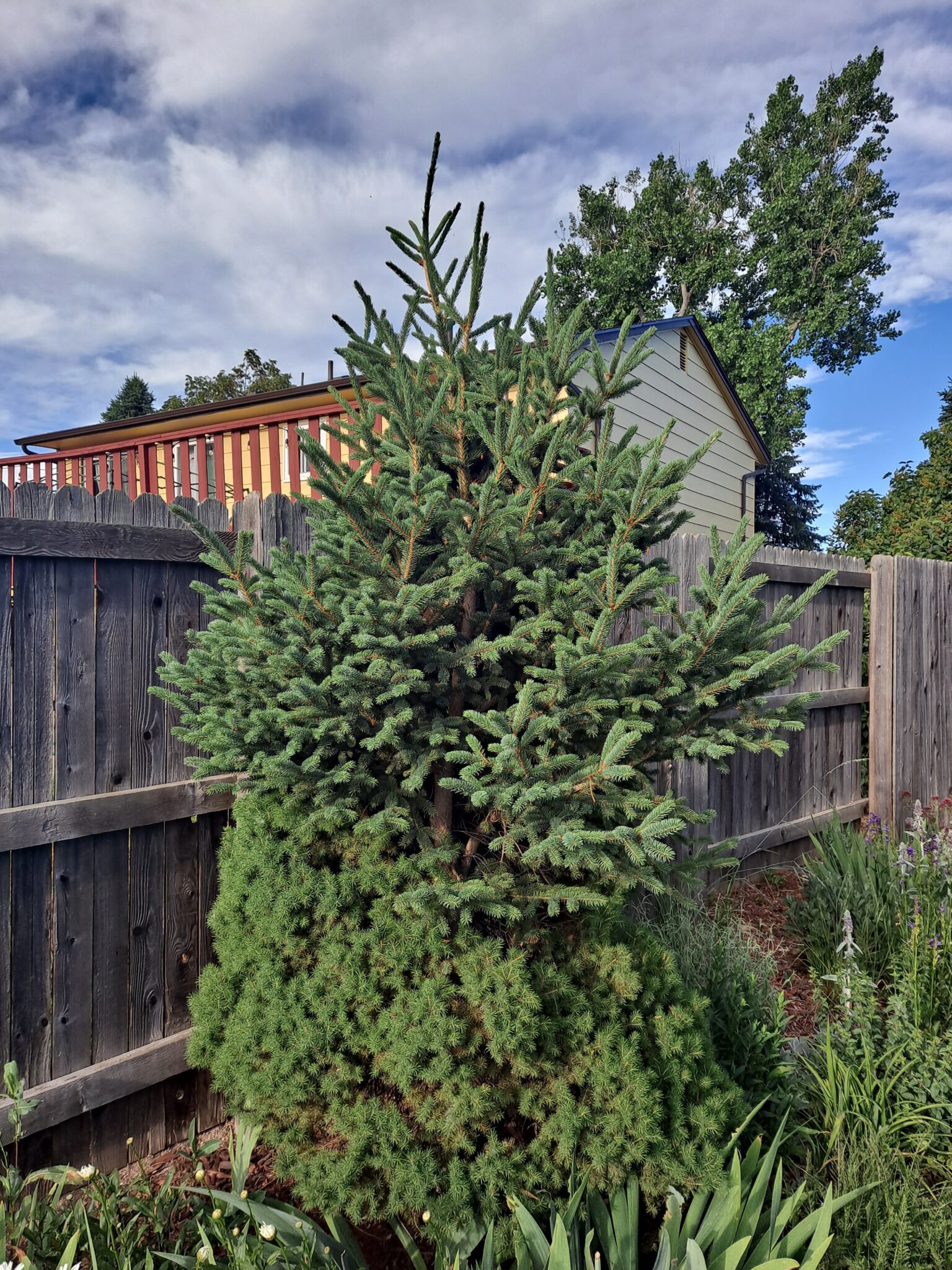
On part of the spruce a branch with different needles appeared. These needles were more like a normal spruce tree, not like the tightly bunched mini needles one would find on a dwarf Alberta spruce. This was mutation of some kind. This type of mutation is known as a “witch’s broom”. Plant breeders love finding witches brooms. They use various means to propagate them, and every once in a while, they produce a plant that is on some way a superior specimen to the original plant. Lots of money to be made if it’s successful.
My witch’s broom on the other hand, was a reversion to the mean. It looked like a full-size spruce was growing out of my dwarf spruce. This is my theory: part of the tree genetically reverted to its natural form, away from the highly cultivated form that is a dwarf Alberta spruce. Mind you, this is just a guess, since I am no arborist or botanist. Either way, the damn thing looked like something out the 1982 horror movie “The Thing”!
So I tried to cut the offending mutation out. It did not go well:
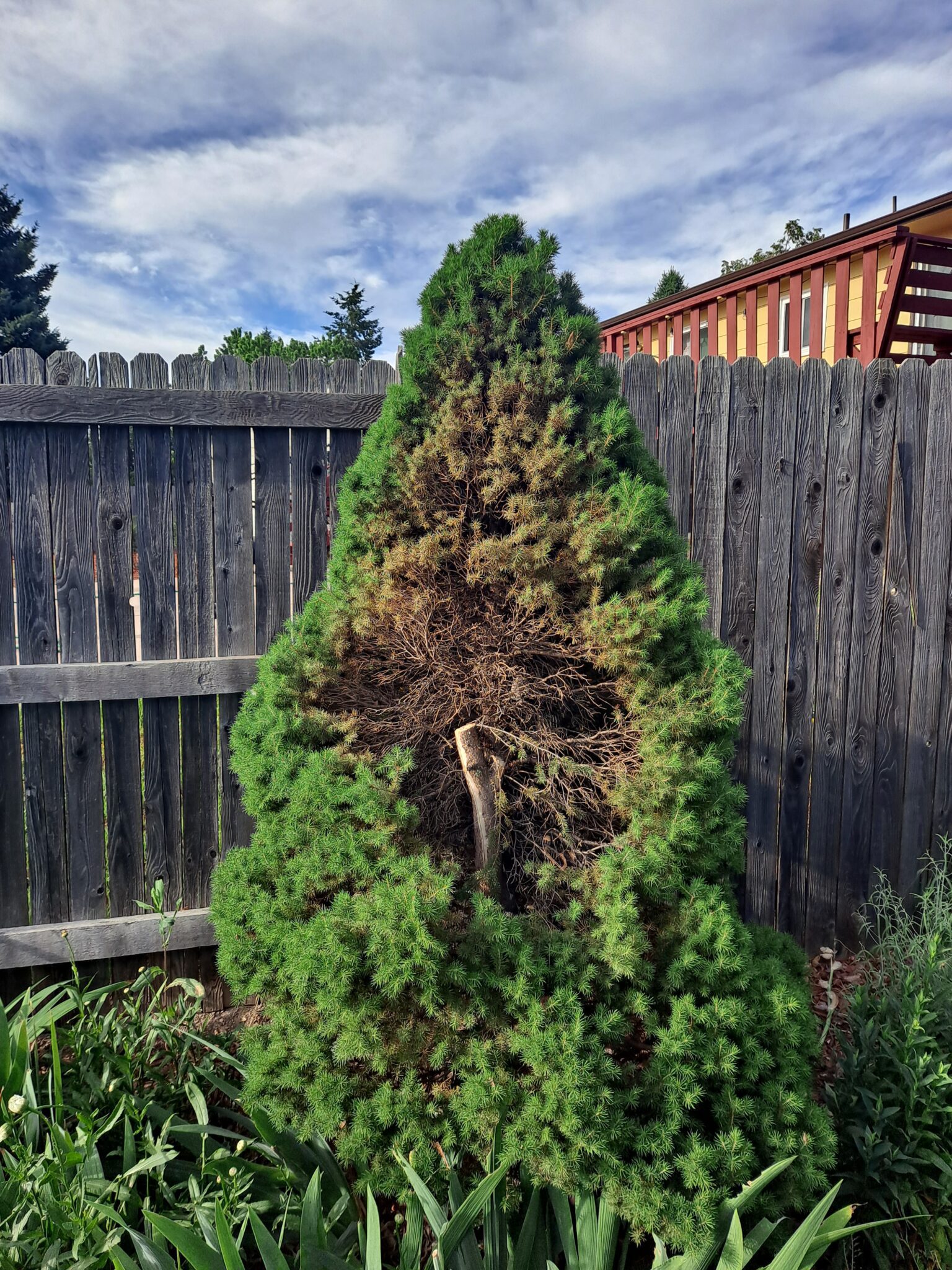
So out it came:
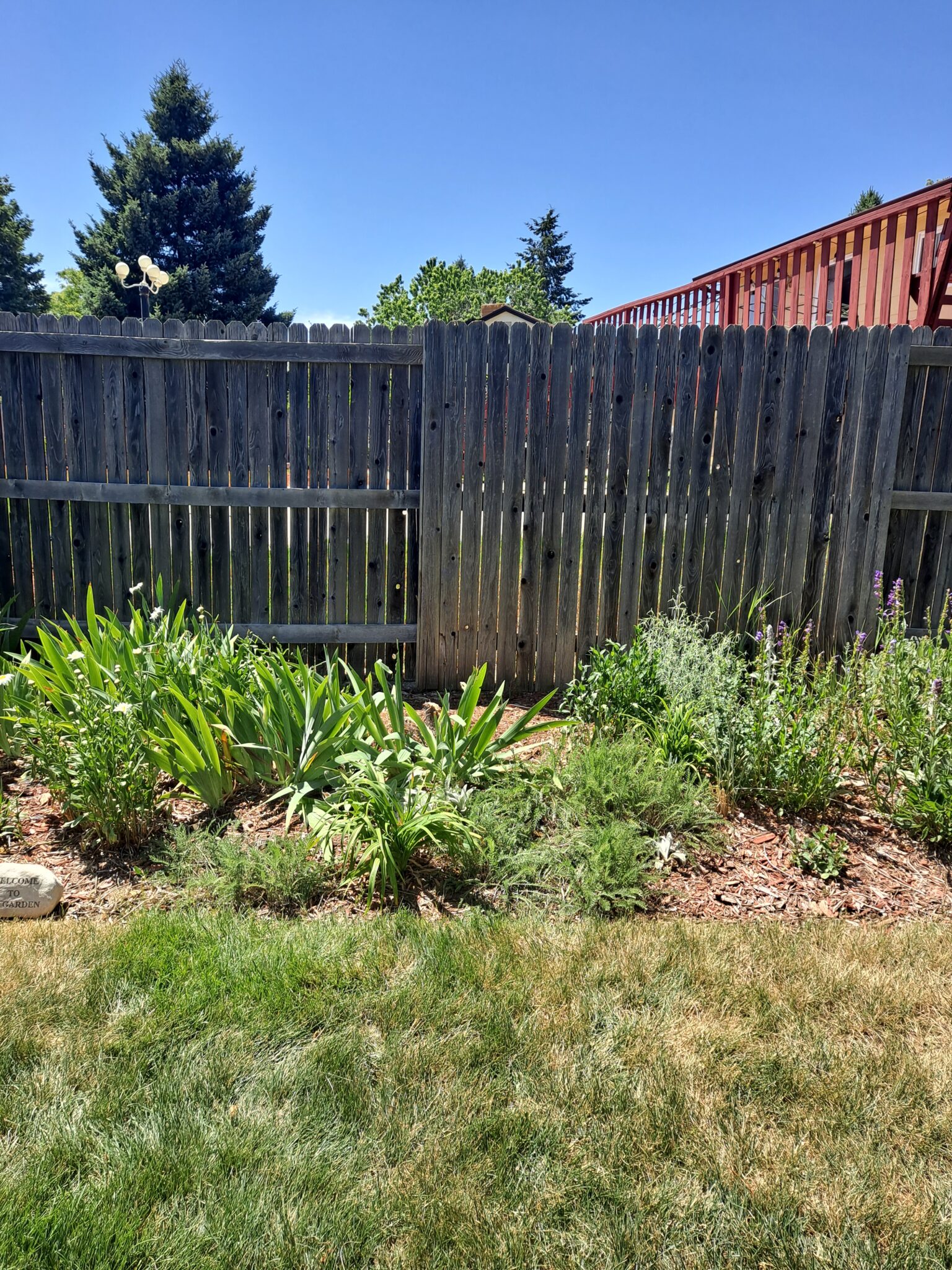
Changes to the corner grass border
I have never been happy with the so-called “ornamental grass corner” in the backyard. It has never lived up to my expectations:
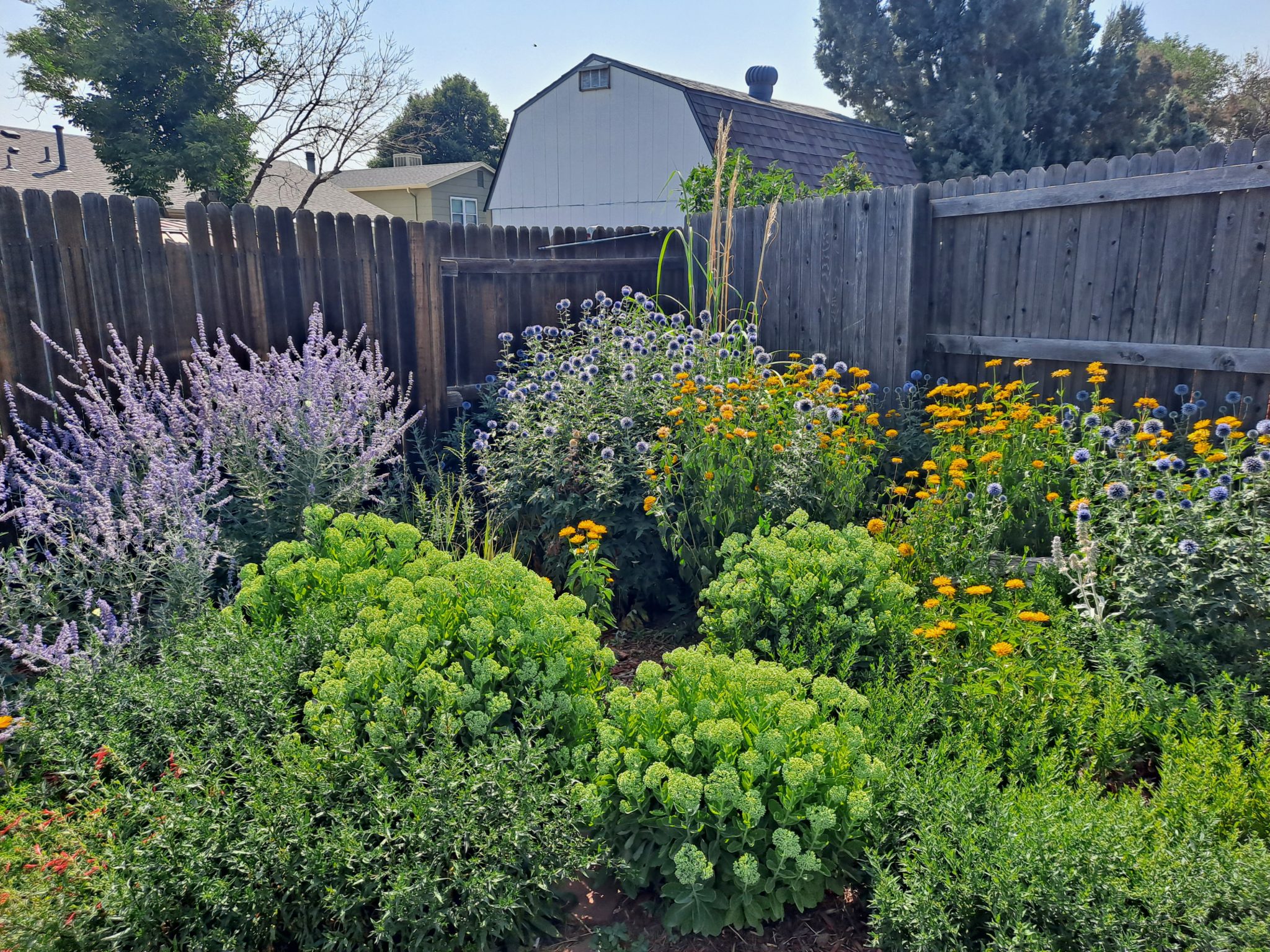
Most of the grasses I planted have vanished, and the area is being overrun by Russian sage and blue globe thistle. The one grass that has remained, a hardy pampas grass, has seriously underwhelmed. It’s supposed to get about six feet tall, with plumes that can reach up to 10 feet. As you can see in the photo above, it’s not really all that impressive.
So I dug out the pampas grass, as well as scads of the blue globe thistle and Russian sage. Last fall I plunked three of the ‘Karl Foerster’ feather reed grasses that I had salvaged from the front yard into the area.
This spring, in the place where the pampas grass was, I planted a Miscanthus ‘Dragon Fire’. It too is supposed to get around six feet tall, but in autumn it’s supposed to turn a blazing red color. I know it’s not much to look at right now, but hopefully next year it will really put on a dazzling show.
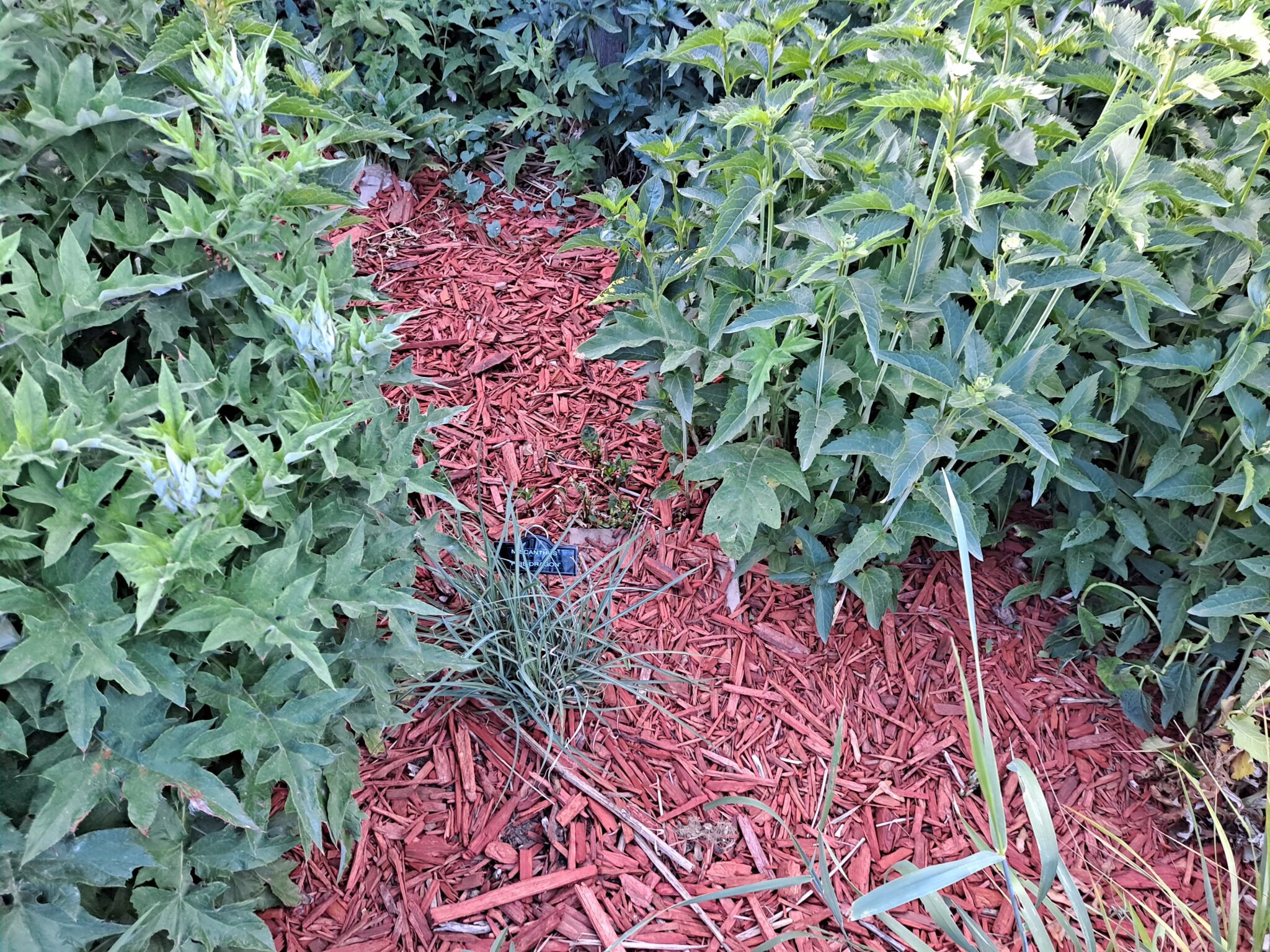
I ordered 3 ‘Red October’ big bluestem grasses. It too is supposed to put on an amazing autumn display as well. Unlike the Miscanthus, big bluestem is a native to the western U.S.
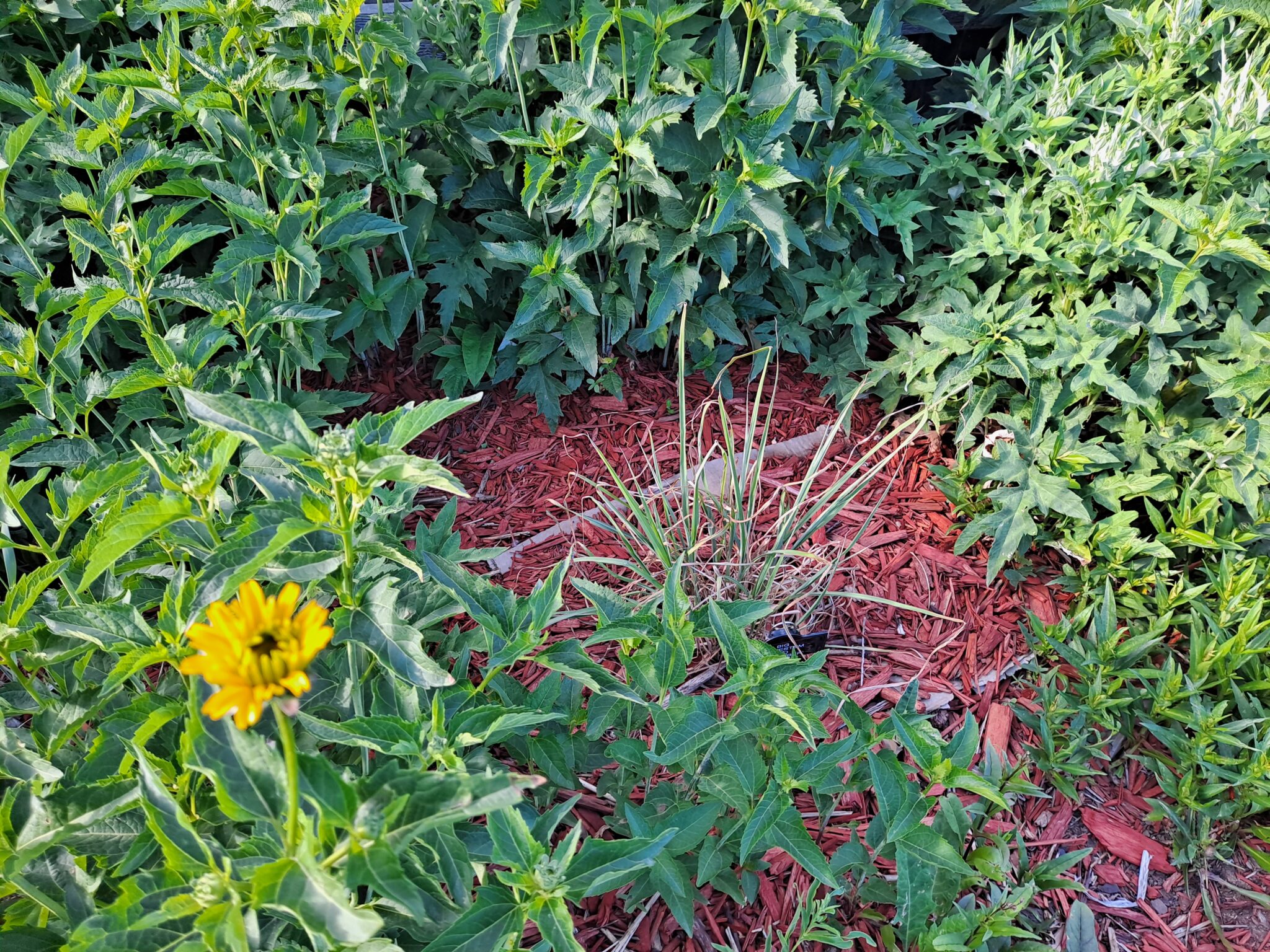
Unfortunately, only one of the bluestems is doing well. I ordered these grasses from an online nursery called Plant Addicts: (https://plantaddicts.com/), and one of the plants was damaged by UPS during shipment and never arrived. The 2nd plant did arrive, but went into transplant shock soon after I put it in the ground:
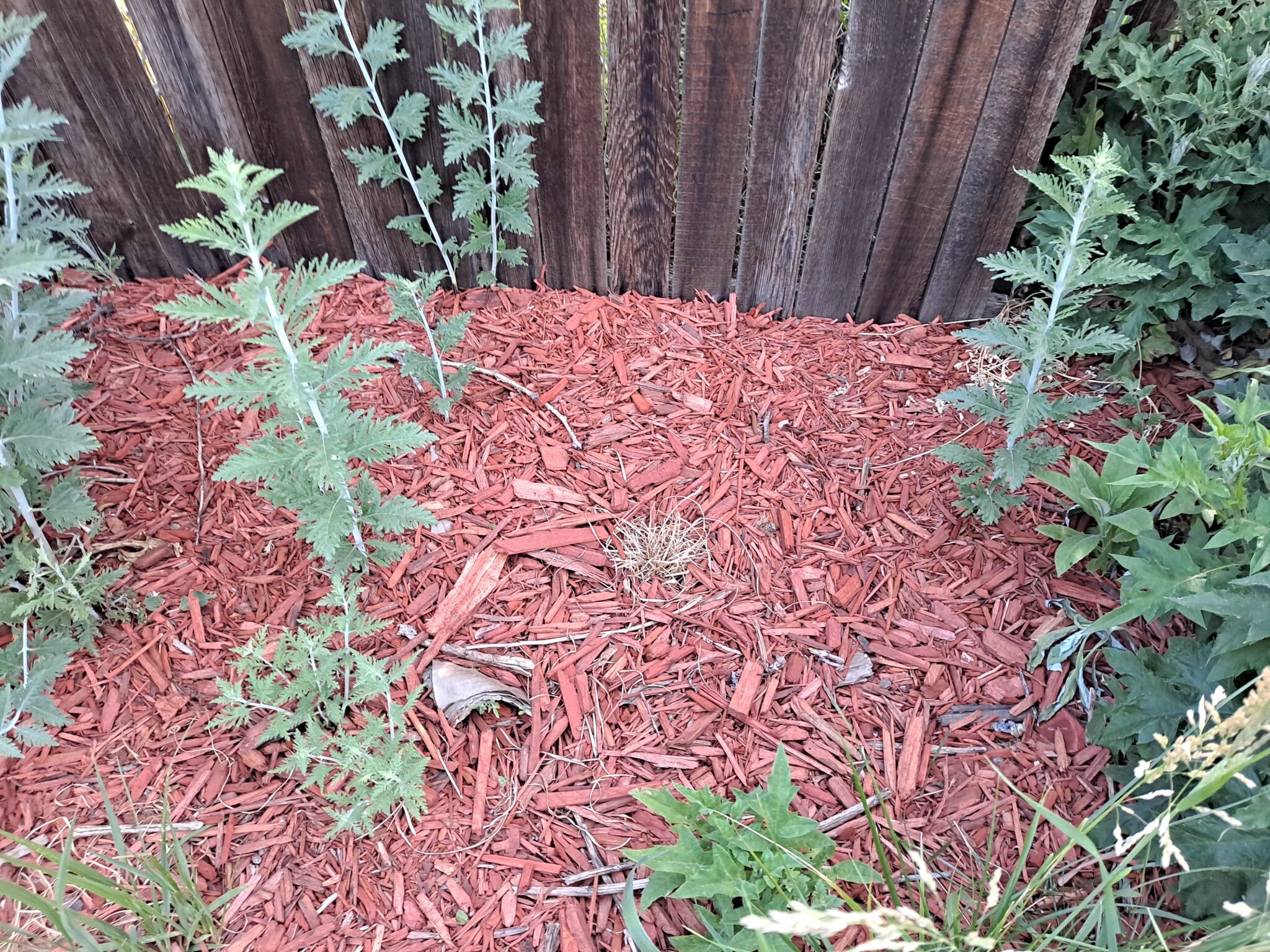
I am 98.5 percent sure that this grass is dead, but I’ll keep watering it over the summer in hopes that it might bounce back.
Unfortunately, I am now unable to find a nursery with this grass still in stock. Not that I would want to plant in the middle of summer anyway. The odds of a summer transplant surviving are not good. My hope is that at least one nursery somewhere will have ‘Red October’ in stock for fall planting. Otherwise, I will have to try again next spring.
Plant Addicts gave me a full refund on not just the damaged/missing plant, but the one that went into root-shock as well. They are a small, family-owned nursery, and I highly recommend them should you want to order a more unusual plant for your garden.
Anyway, here is what the corner grass border looks like in late June;
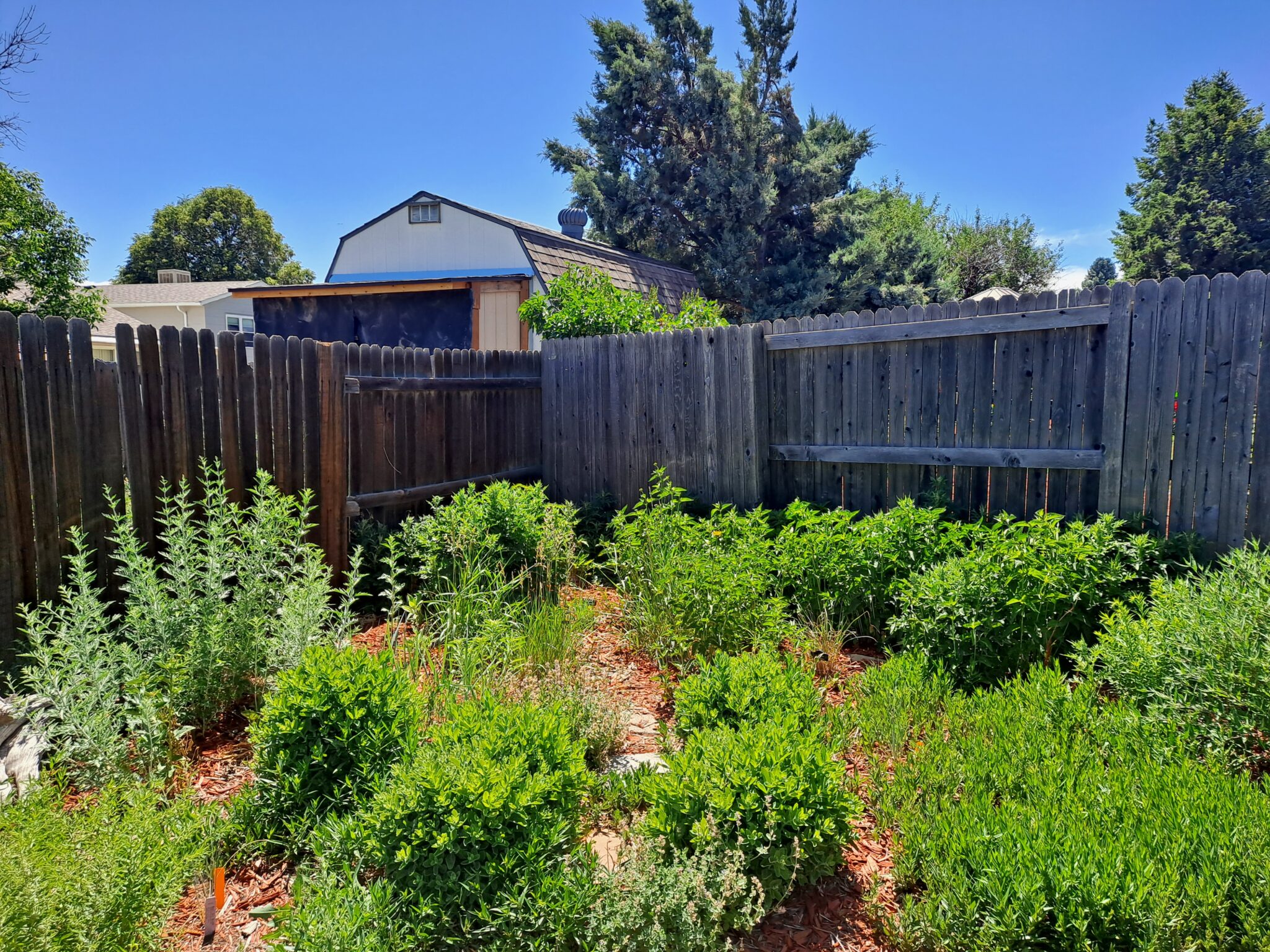
Make your own organic weed killer
I found this home brew organic weedkiller on a blog written by a woman who gardens in Arizona: Blog – Desert Gardening 101 (azplantlady.com) It only requires two ingredients and a spray bottle. And it is extremely effective for most weeds.
Fill a spray bottle about 2/3 full with vinegar, and 2 or 3 tablespoons of dishwashing soap, then shake it up. Any vinegar will do, but I use a general-purpose vinegar because it’s a little bit stronger than white vinegar. You don’t need to be precise on the soap. I just eyeball it.
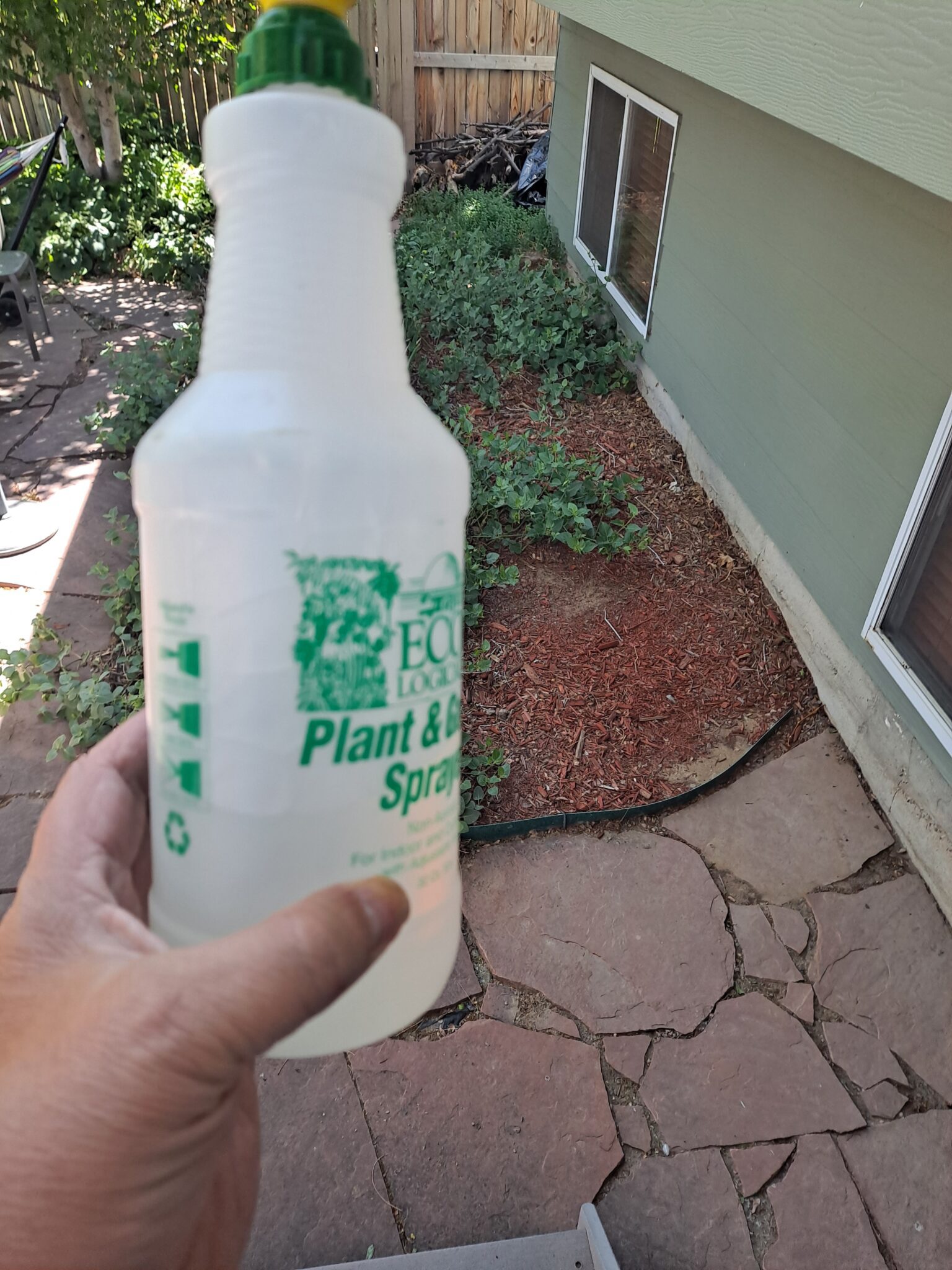
The dish soap strips the protective coating off the leaves and helps make the vinegar stick to the surface of the plant. The vinegar sucks the moisture out of the plant’s cells.
Spray offending weeds on the morning of a warm/hot and sunny day, and by nightfall the transgressor should be toast. Check out these before and after photos:
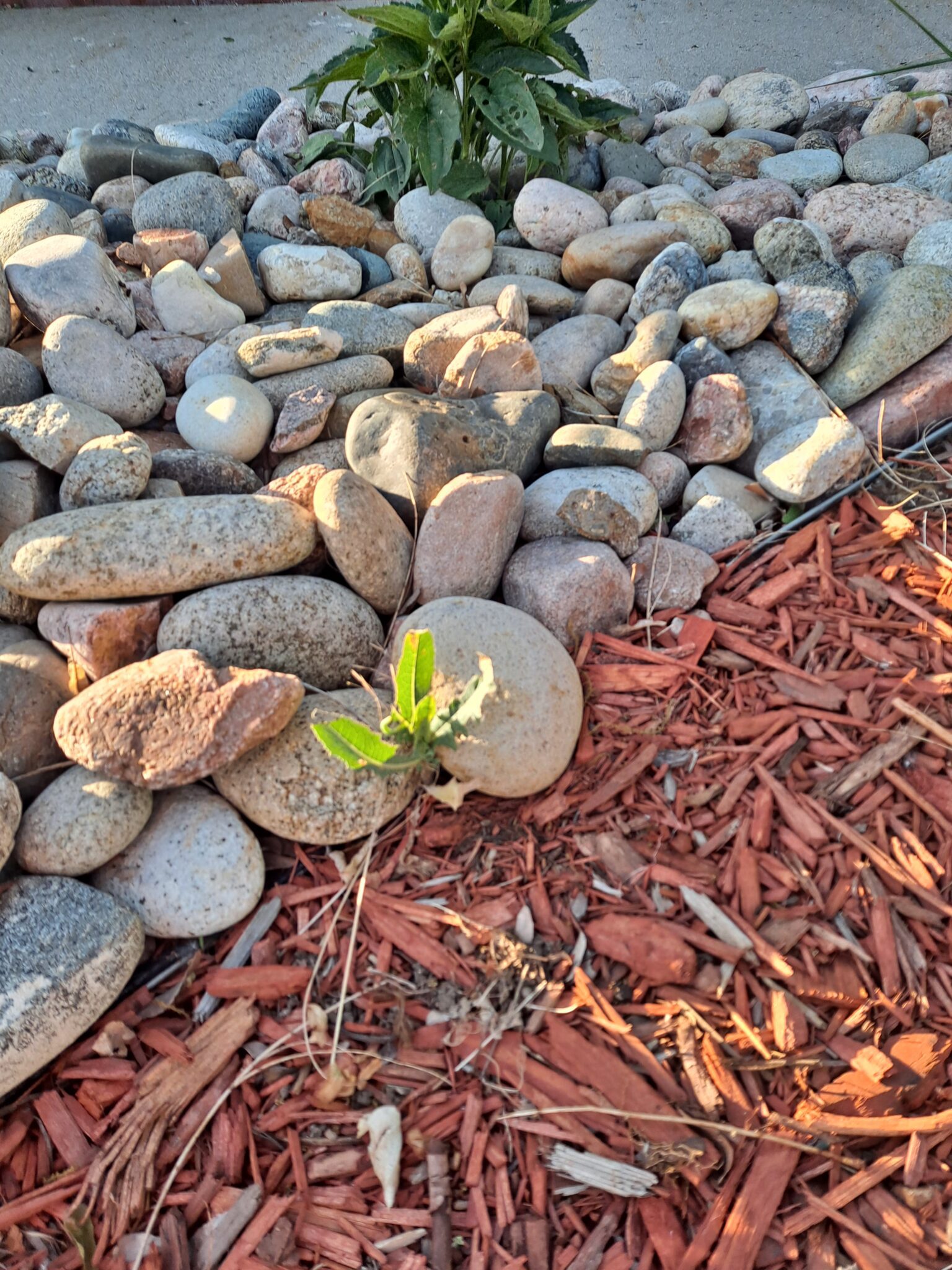
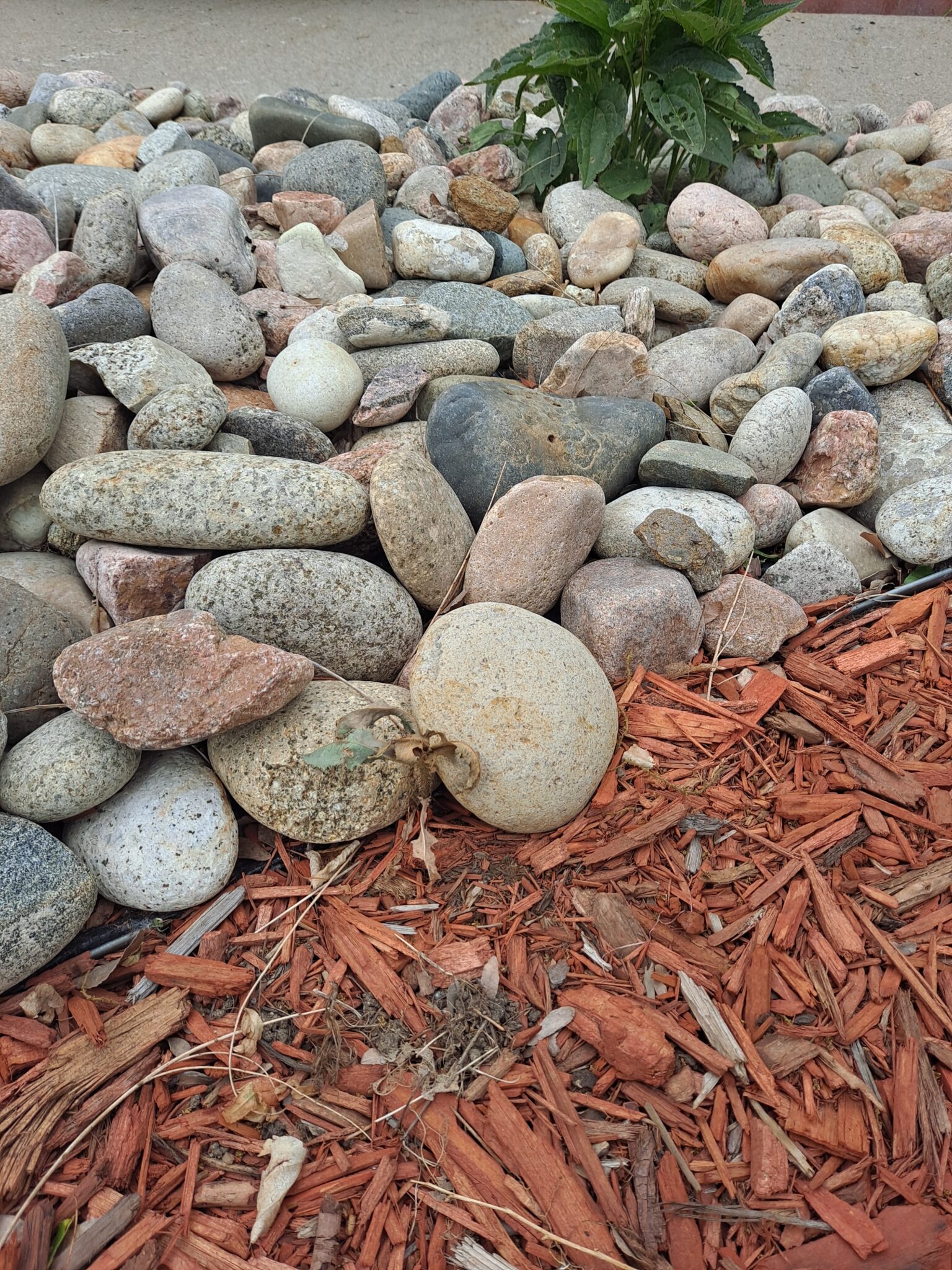
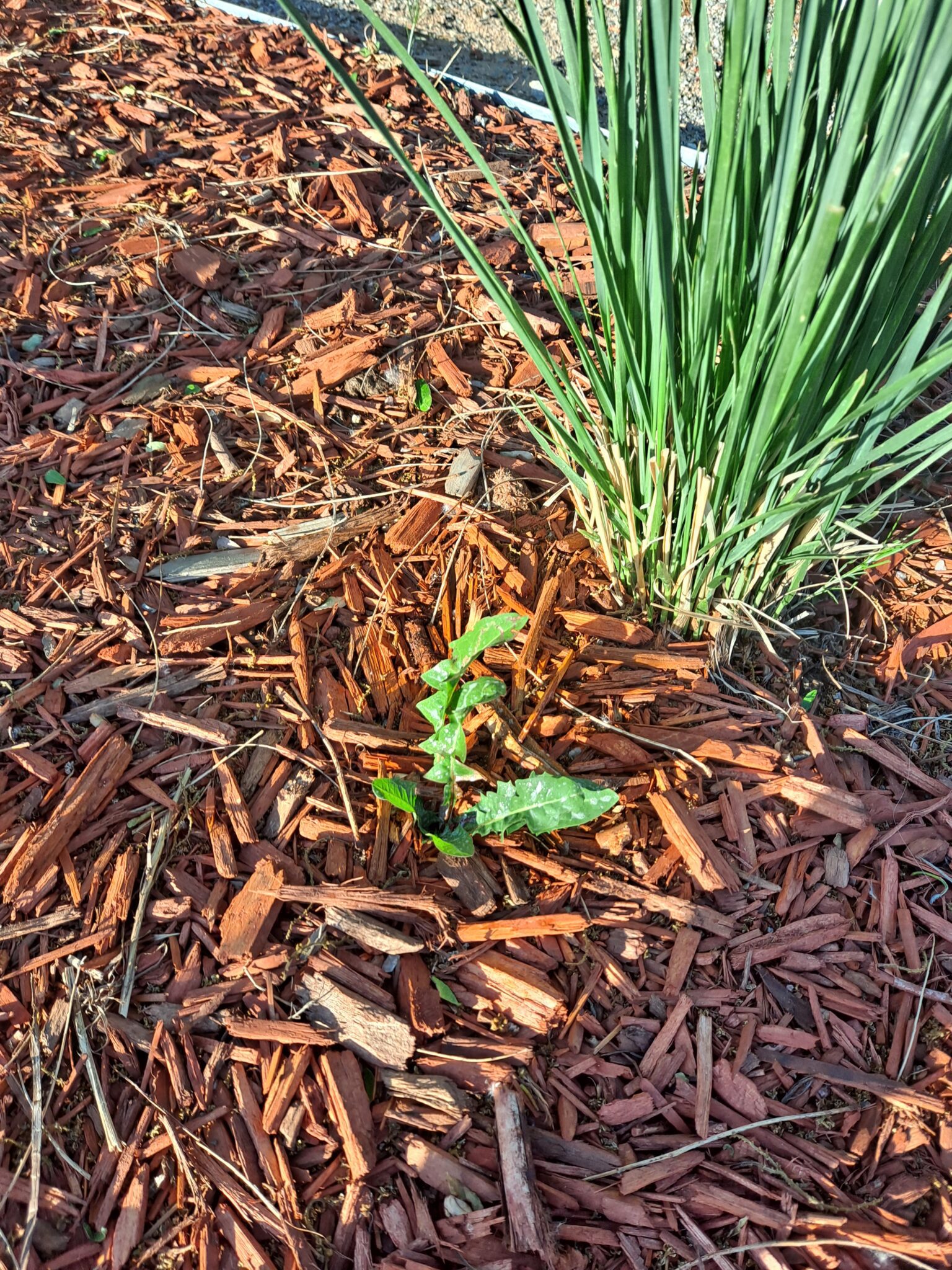
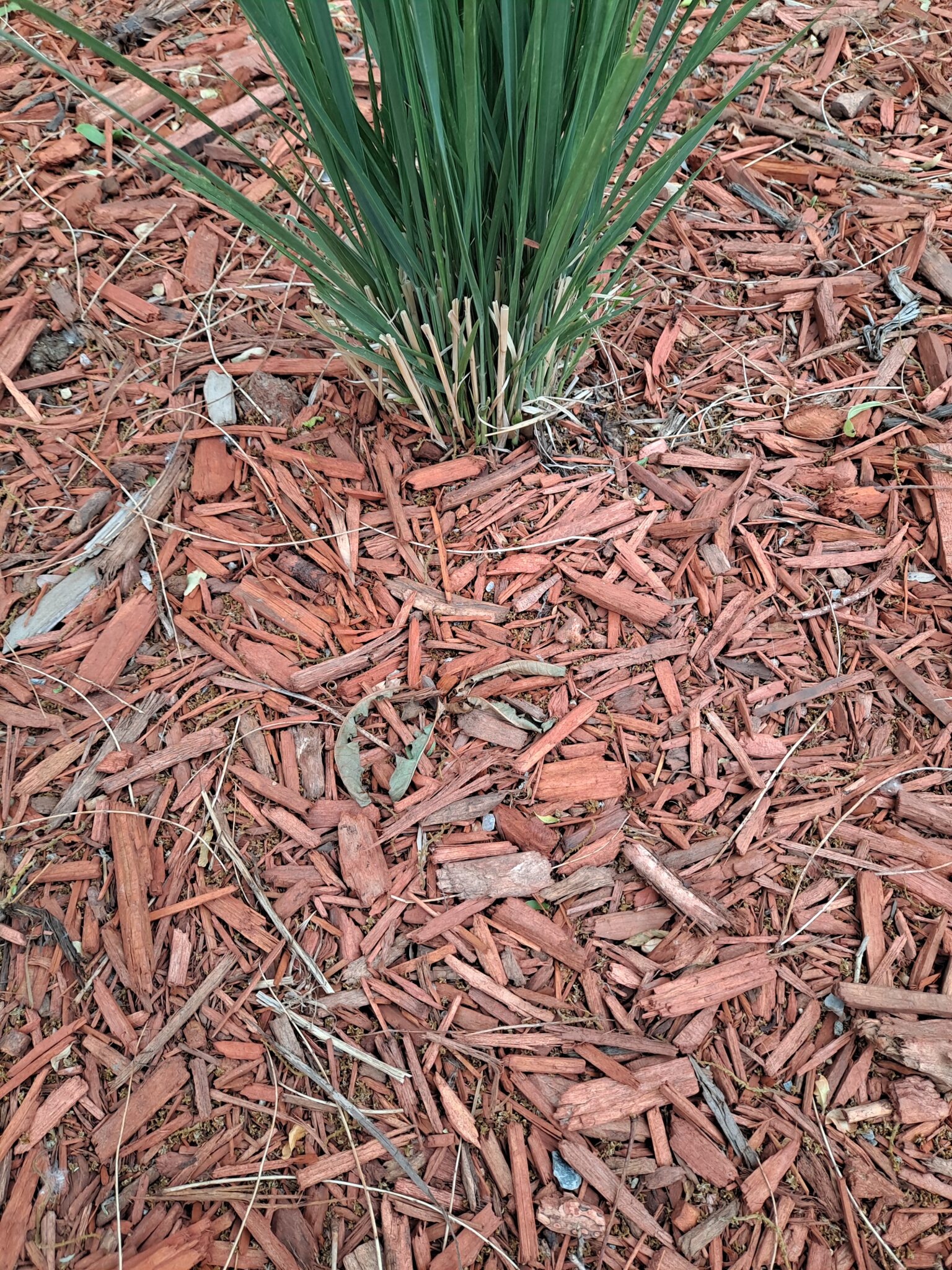
I feel a near psychopathic glee in watching weeds shrivel.
I will throw a couple of caveats about this concoction. Caveat number one: unlike weedkillers such as Roundup or Weed-be-gone, this formula will not kill the plant’s roots. You may see the weed sprout up again. Blast it with the vinegar mix again as needed, and eventually the plant will give up the ghost.
Caveat number two: some plants are hardier than others. I’ve sprayed bindweed and sometimes I’ve had success. But if the bindweed is fairly well established, the spray only mars the leaves a little and the rapacious bugger soldiers on. Plants such as bindweed can have roots that run for feet, which means they can laugh at my puny vinegar weedkiller. Roundup or Agent Orange is your friend for invaders such as these.
I shouldn’t have to say this, but I suppose I better: DO NOT USE THIS ON WEEDS IN YOUR LAWN! It will damage the grass surrounding the weed. Also, when using in flower beds or veggie patches, spray carefully as to avoid damaging the plants you want to keep.
Some modifications to the front yard scheme
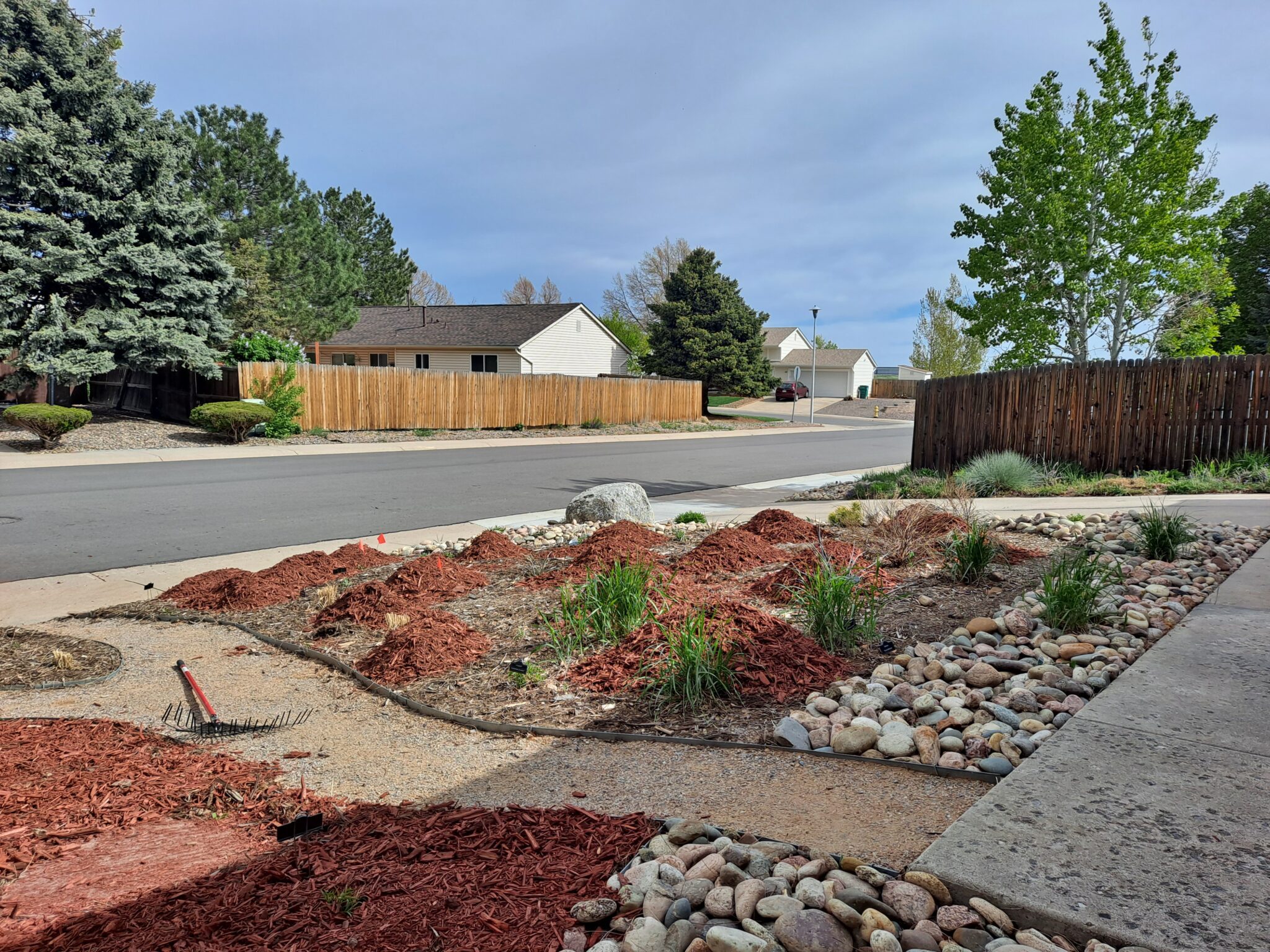
I spoke earlier about the front yard renovation. Let’s see what’s going on there.
MrsVintage finally convinced me to put down dyed wood mulch down. I was resistant at first, mostly because I didn’t want to do the work. But she was right about the old mulch. It looked fine last year, but this spring it looked faded and unsightly. Truthfully, it made our front yard look like a vacant lot. So, amidst much grumbling and two trips to the landscape company with the truck, the new mulch was put down. It definitely is an improvement.
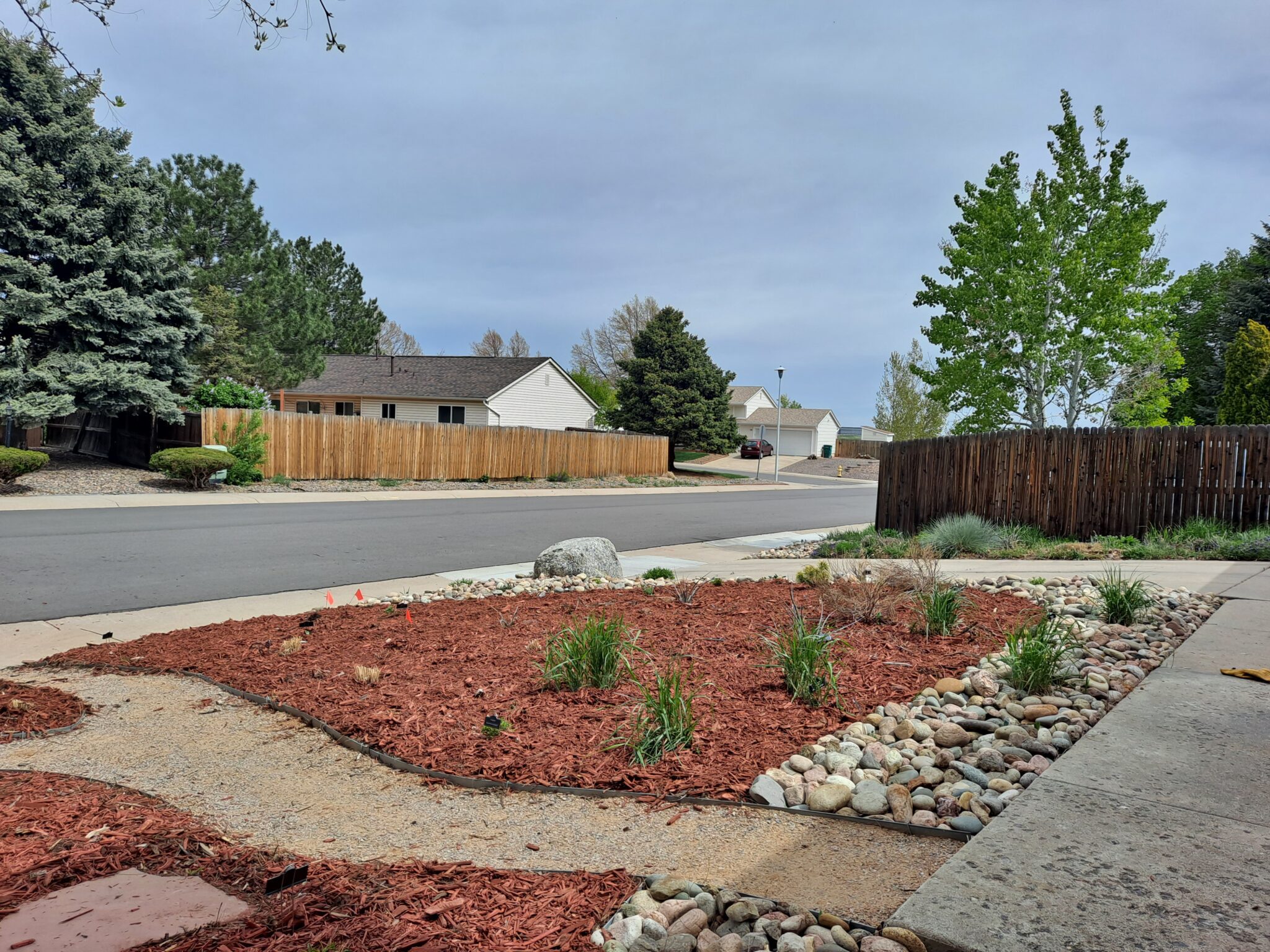
I also replaced a couple of plants than ran along the front sidewalk. The bunnies really did a number on the Turkish veronicas, so I replaced them with two varieties of prostrate sedums. I know they don’t look so good in the photos, but trust me, they look better in person. I took these pics around noon, and the harsh light makes them look sickly:
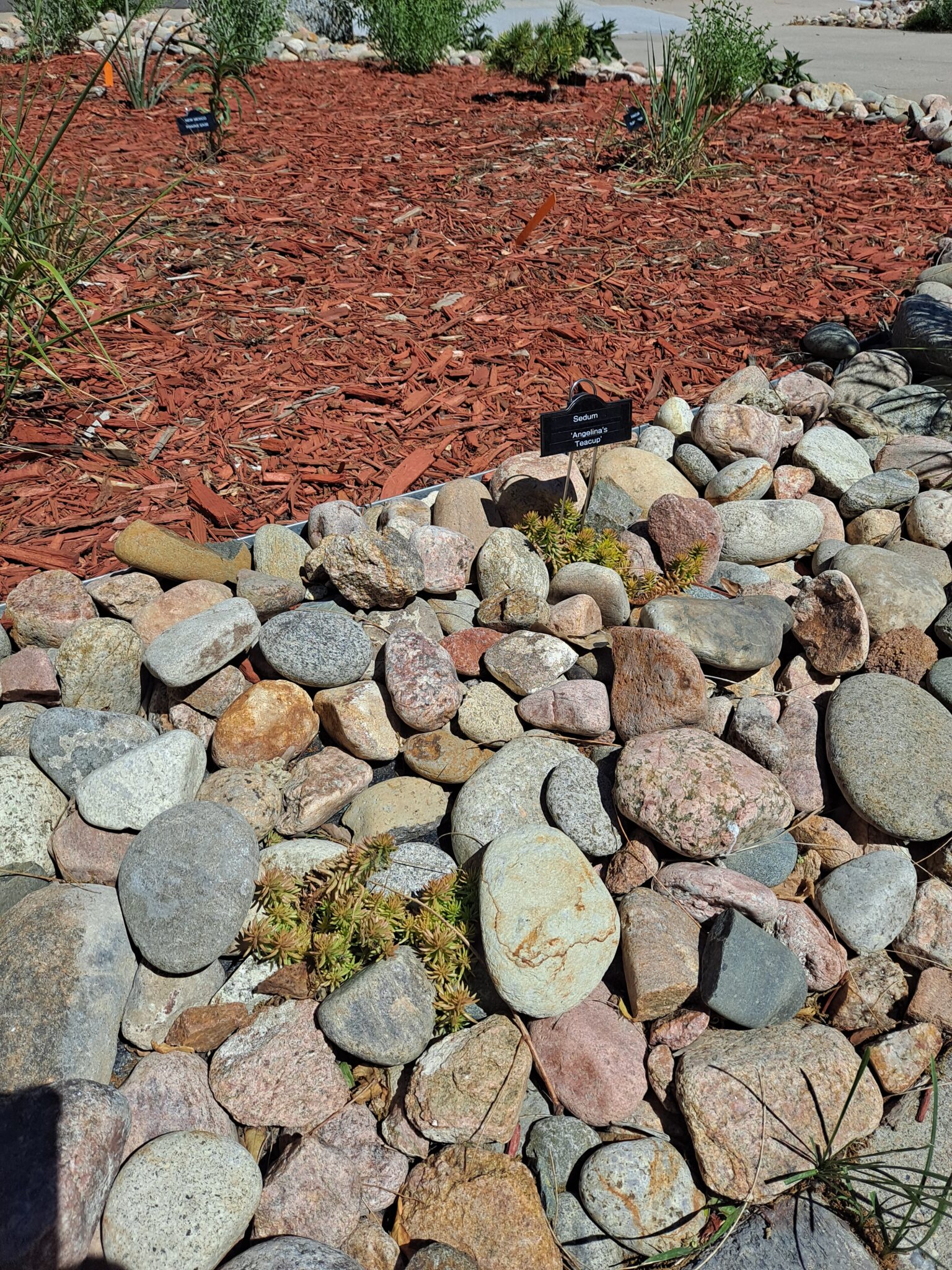
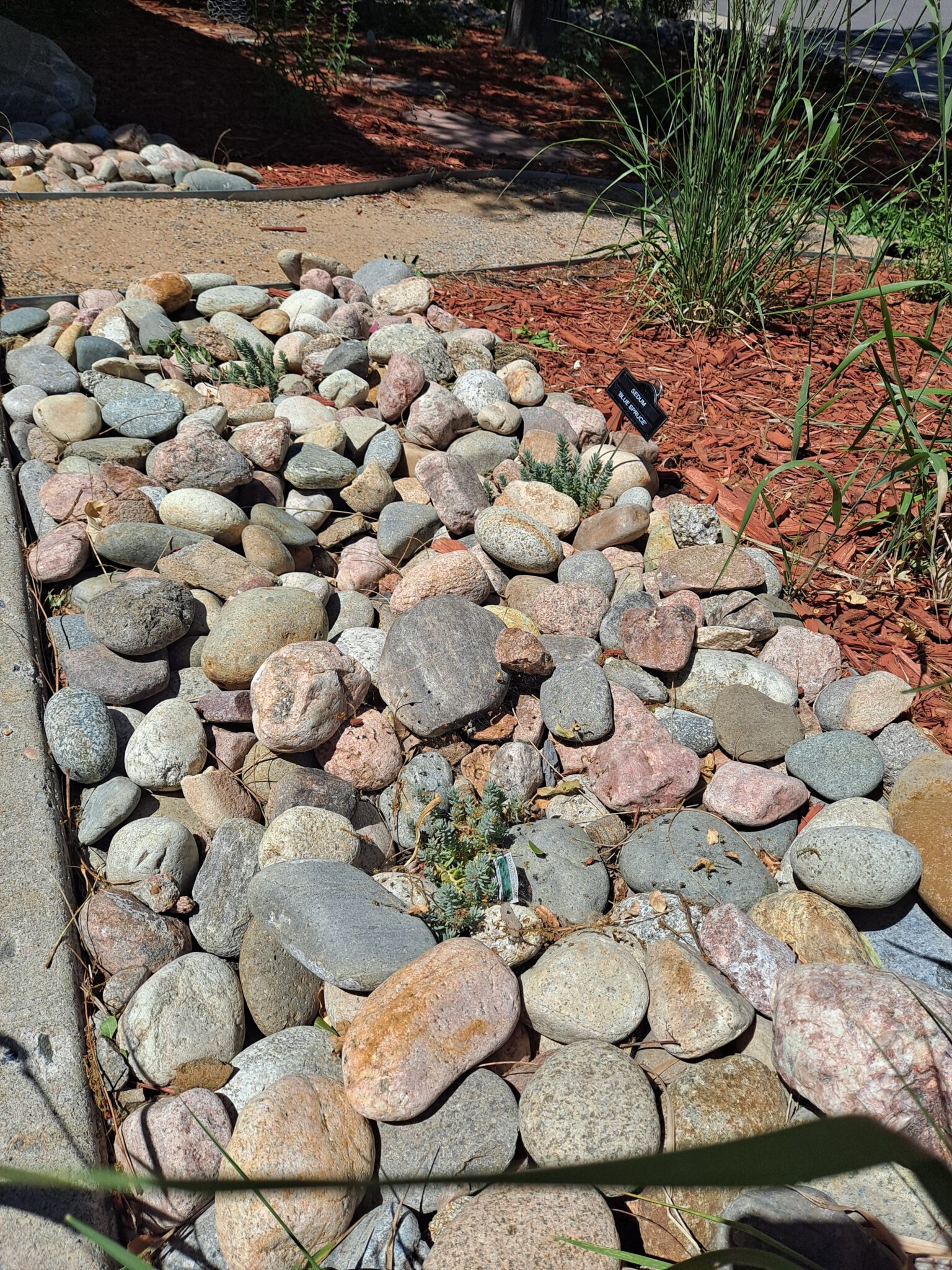
The three ‘Goblin’ blanket flowers I planted in the raised bed by the house all died. I replaced them with ‘Arizona Sun’ blanket flowers. Hopefully this cultivar will prove to be more robust.
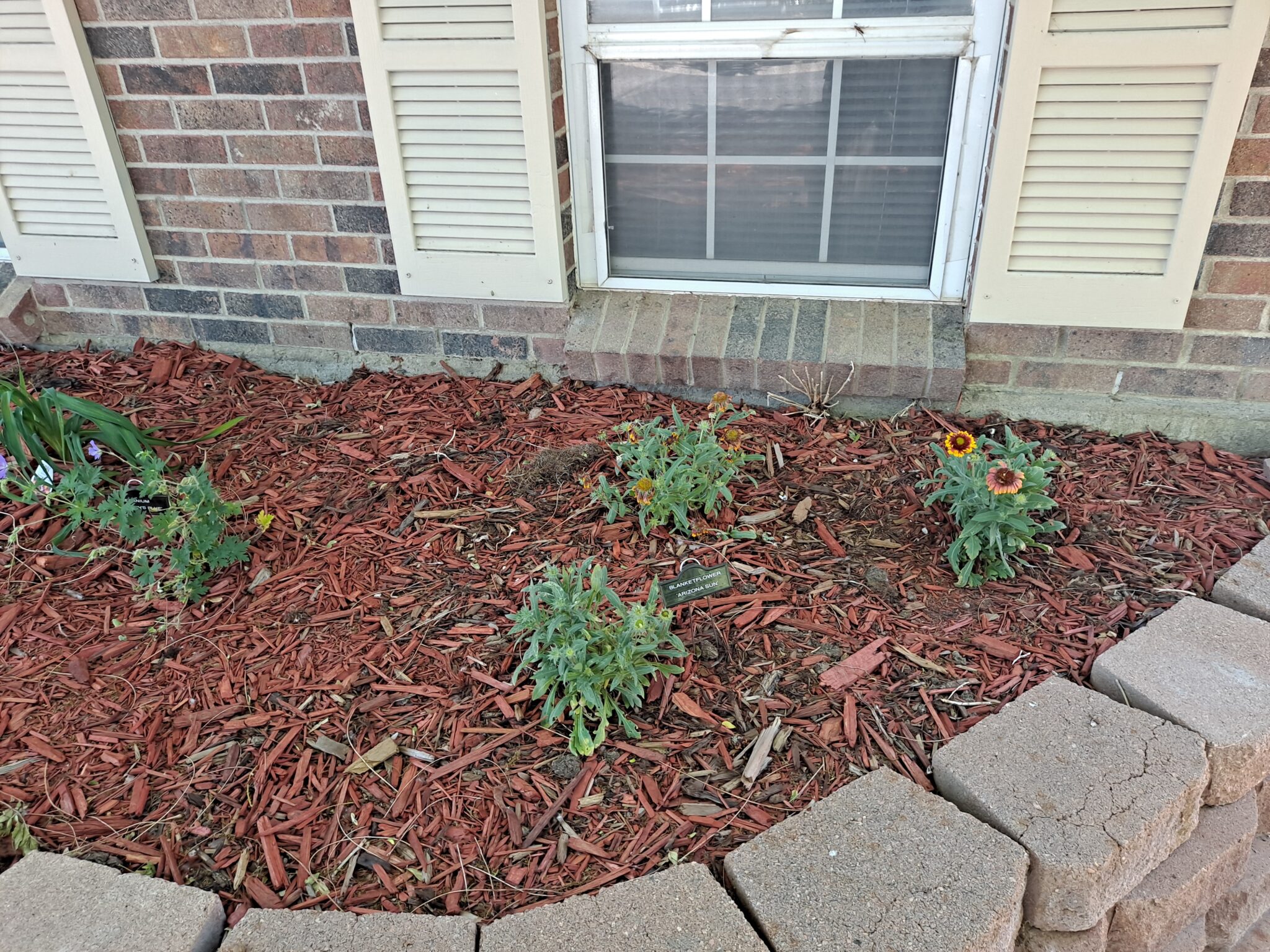
Elsewhere in the front yard
Speaking of the front yard, let’s see how things are faring from last year’s renovation. Should be a dramatic difference from last year, yes?
No.
I’ve mentioned the old adage about perennials before: first year sleep, second year, third year leap. The plants are still getting settled into their new homes. Hopefully, next year I will have a more impressive display to show you.
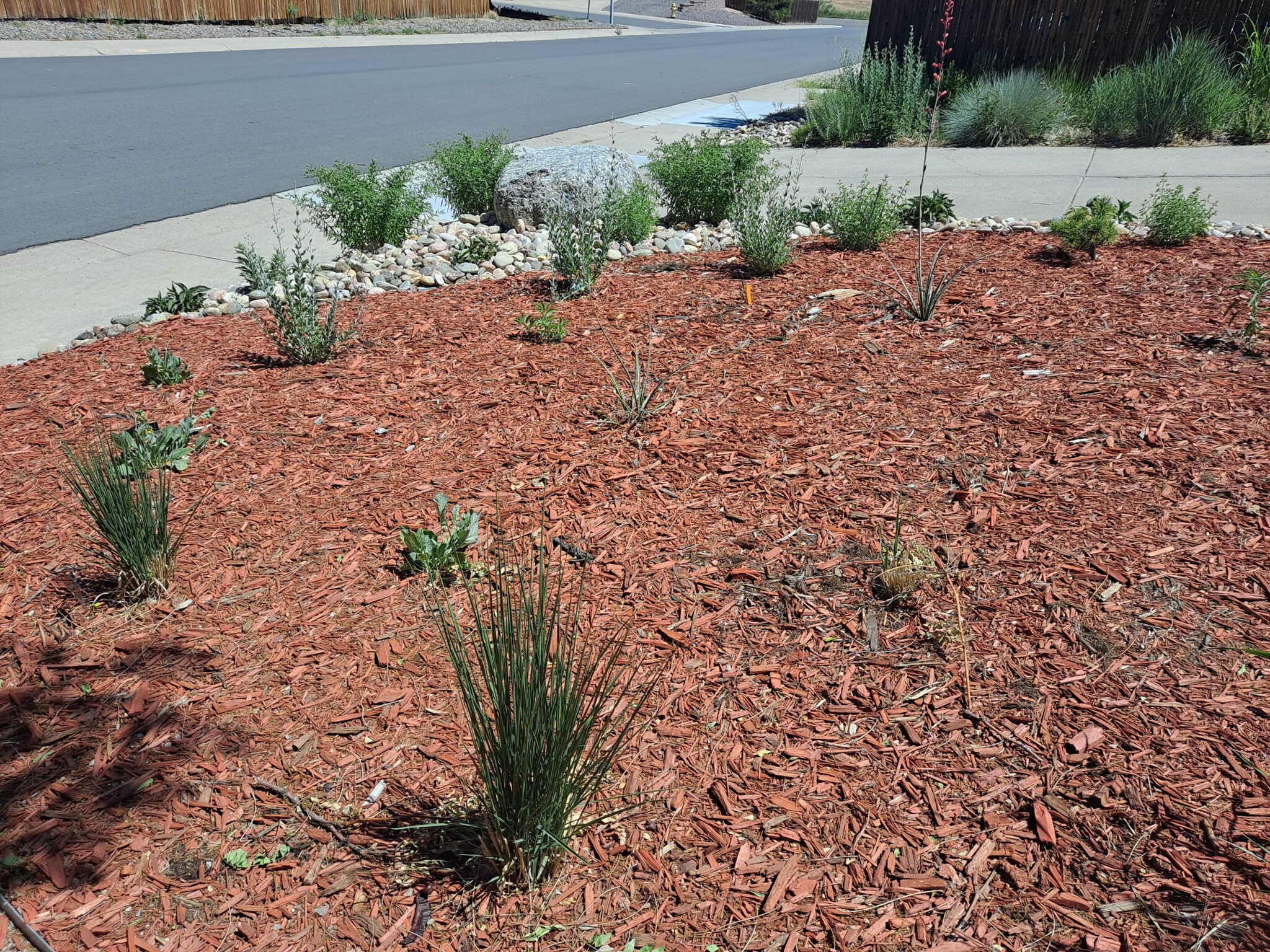
There is one exception though. These ‘Karl Foerster’ feather reed grasses are growing like gangbusters:
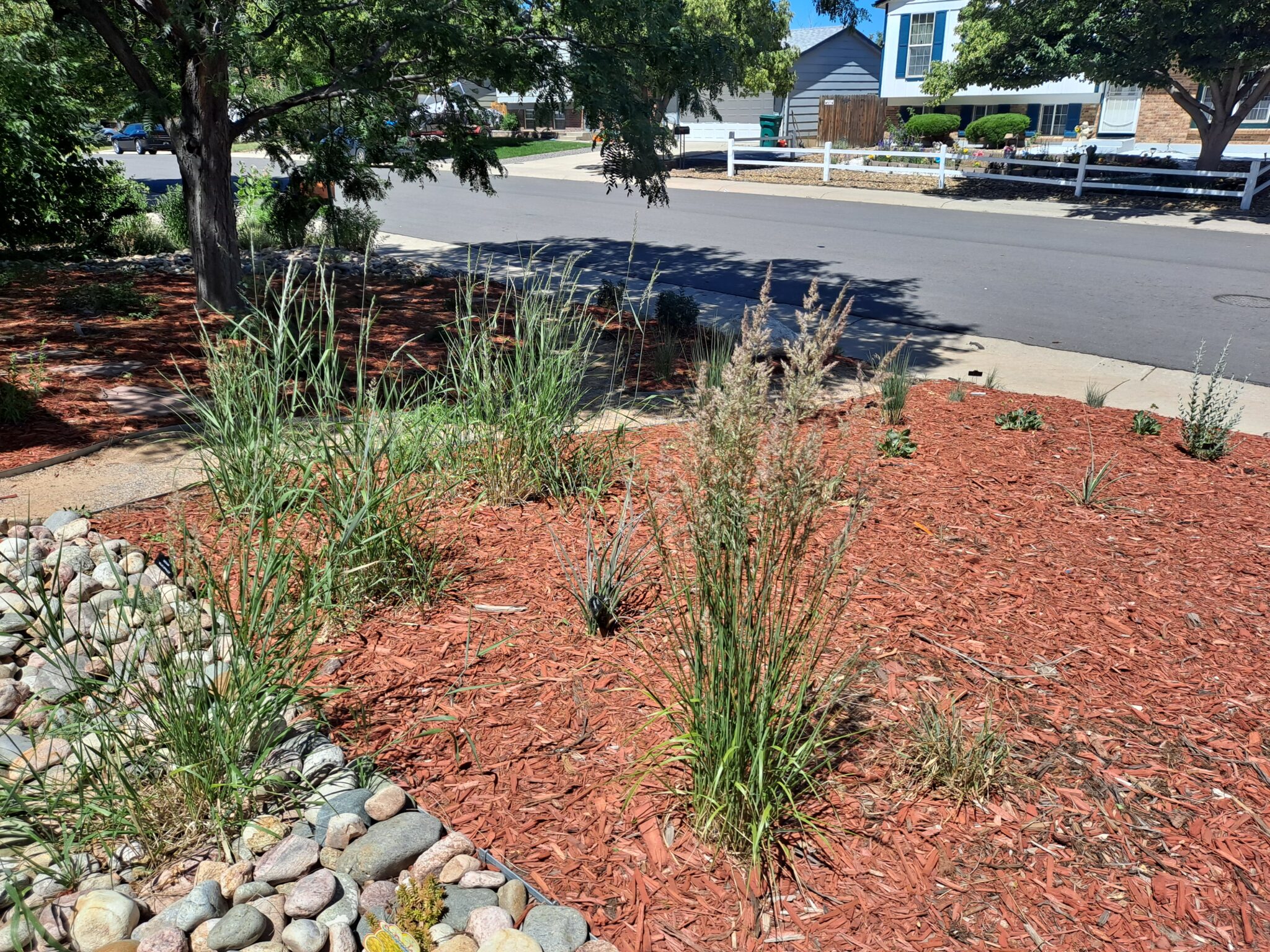
I have a theory as to why these grasses are doing so well. (I have lots of theories). I salvaged these grasses from the front yard before we started the renovation, storing them in pots for a few weeks, and then put them in their current homes which are very close to where they were growing before. So, these particular plants are already used to growing in hard clay soil of the Vintage Garden.
The store-bought plants, on the other hand, grew up in a loose and friable potting medium. Being forced to adapt to a new environment has made them a bit sulky. They’ll catch up eventually though.
Quick check-in on the desert garden
A couple of years ago, MrsVintage and I overhauled the yard on the south side of the house. It was overgrown with bindweed and spotty grass and was truly ugly (Big things happening in the Vintage garden). We now call this area our “desert” garden. Let’s take a peek and see how it’s doing:
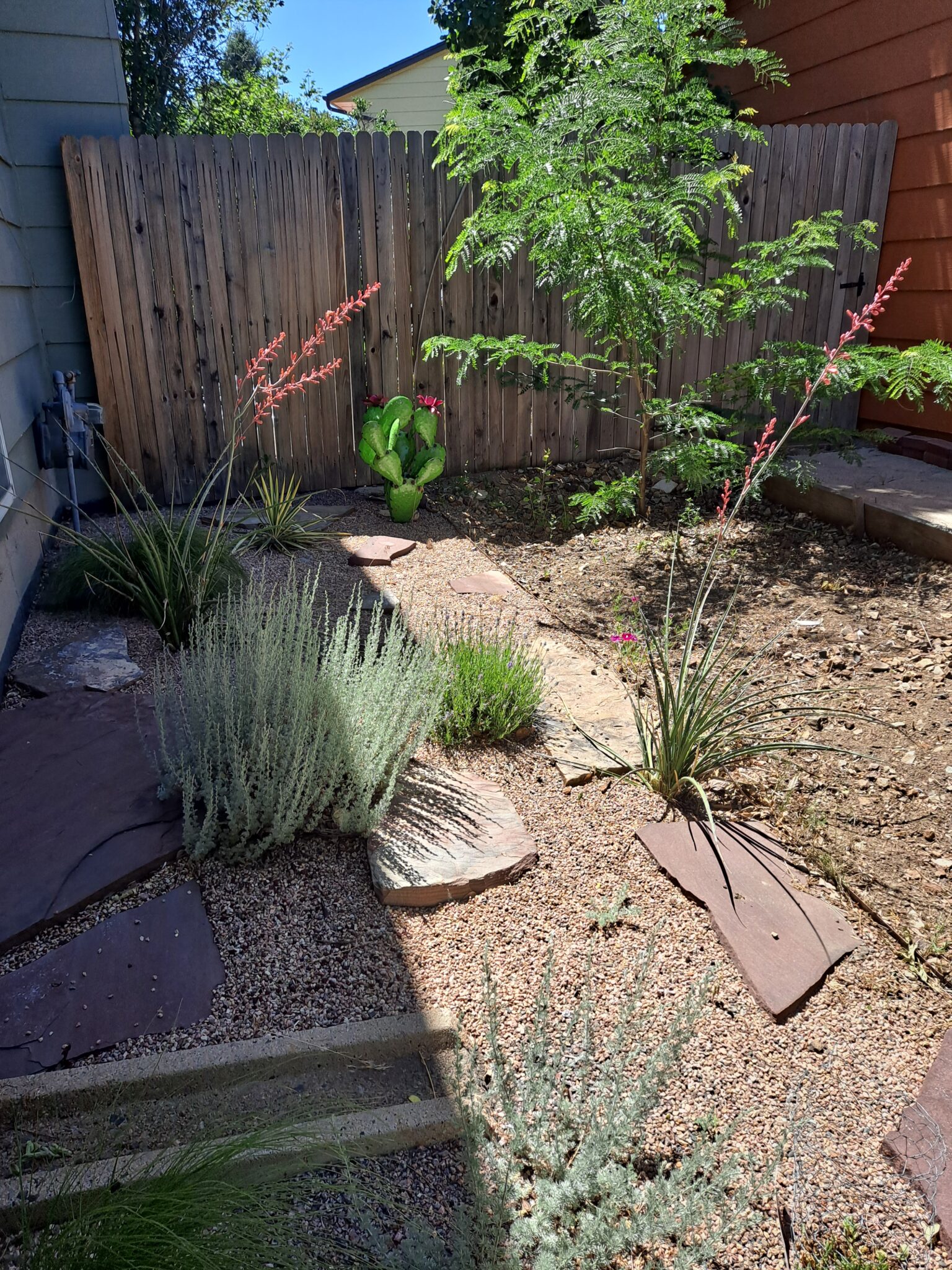
It’s doing quite well, as you can see. We even added a little ornamentation to enhance the desert aesthetic.
And finally, attempting tomatoes in a pot again
I have been attempting to grow tomatoes in containers for several years now. My efforts have been underwhelming to say the least. But when it comes to growing homegrown tomatoes, I am not one to quit so easily.
This year I picked up a determinate tomato called ‘Mountain Merit’. A determinate tomato puts on a flush of tomatoes all at once, and then calls it quits. Indeterminate tomatoes keep growing and producing until they tucker out or get zapped by frost. Indeterminates get quite large and gangly as the season goes on. Determinates usually don’t get so big.
I am hoping that by growing a determinate tomato I’ll finally get a decent harvest, and hopefully the plant won’t grow out of control in its confined growing space. Stay tuned.
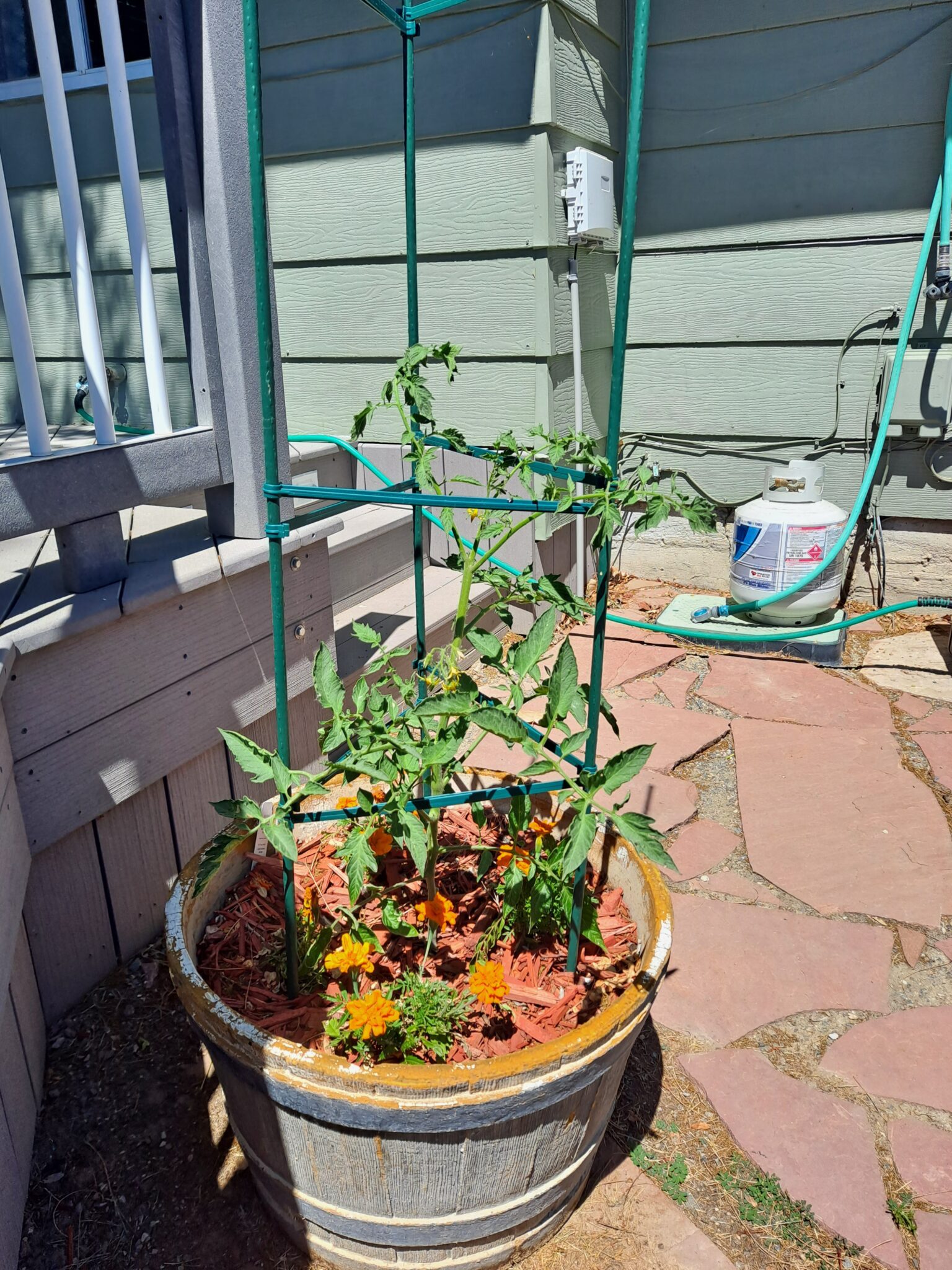
So, how does your garden grow so far this year?

